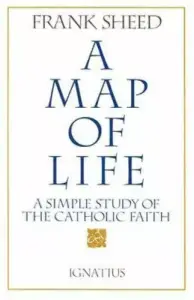‘Map of Life’ good is a short and clear explanation of the Catholic faith. It takes the complexity of theology and brings it down to a level that the average Catholic or inquirer into the Catholic faith can understand without having his brain hurt too much. It lets him know there is a purpose in learning about the Catholic faith, which bears great relevance to his life. “God who made us and knew what he made us for has told us what he made us for. Accepting his Word, we know the purpose of our existence, and we can proceed to live intelligently according to it. Short of this knowledge, intelligent living is not possible for us.” (pg. 12) This book is useful for the catechist who wants ample material for teaching any willing heart and mind who wants to gain knowledge of the inner mysteries of God’s revelation to man. It’s not only a useful tool for catechizing those about their faith, but is a tool for those that digest the book’s truths into a crystal clear understanding of that truth, which is the goal of theology. Challenging and straightforward, pulling no punches with soft PC goulash, Sheed simply and systematically gives the reader his God-given right to know the fullness of what God has revealed through his mystical body.
Some of these truths, for example his Christology in chapter 5, took the church a few centuries to state dogmatically after fusing and fighting during the first four ecumenical councils against such heretical foes as Arius & Nestorius. “Therefore, whether he was acting in his divine nature or in his human nature, it was always the person who acted; and there was only the one person-God. (pg 49) It is amazing that he can reach in to the rich treasury of Church teaching and present a belief that is so simply stated, while it took the Church Fathers blood, sweat, and tears to come to the point where it could be simply stated. But Sheed does not treat the reader if he were a simpleton, he treats the reader as if he had a brain. Sheed does not believe that reason is opposed to faith, but is a tool to be used in understanding the faith, and prepares the reader to use the brain God has given him so that he can understand that faith God has revealed to Him.
Only by understanding what you believe will make you stick by what you believe when the world, the flesh, and the devil try to knock you over with difficulties and problems.

Using reason to cement the understanding of God’s revelation in the brain also helps with acquiring skills in apologetics. This comes in handy when challenges to the faith arise, and they will. It is necessary to prepare those you are teaching to intelligently handle the inquiring questions of skeptics and other curious people. ‘What do you mean that the Pope is infallible?’ ‘How do you explain the bad Popes?’, are some questions that might be asked by such a questioner. Sheed says that the Pope’s infallibility is for the good of the whole church by preserving the church from teaching God’s revelation without error. This work of God has no necessary effect at all on the pontiff who has this gift. “It does not make virtue easier for him or sin less attractive. It does not effect his character, so it does not arise from it. If by chance a bad man is Pope, it is just as necessary for us that he should be prevented from teaching error and just as easy for God to prevent him. (pg 75)
Pure reason, while a good tool in accruing understanding in knowing why the church’s teachings are true and in gaining skills in defending that truth, is boring without imagination. Imagination is simply intelligence having fun. Imagination, Albert Einstein says, is more important then knowledge because knowledge is limited while imagination embraces the entire world. Imagination helps us see the beauty in God’s revelation. Beauty helps us see the awe in revelation and helps us to ponder the mysteries we could not know on our own. Imagination and beauty helps us to know who we are and who God is in relation to us. “Rebellion against god is one of the most ludicrous things in the world. The sinner, as it were, stands in the hand of God, sustained in being by that all-powerful hand, defying God, but in his very defiance using the power God has lent him and that God could at any moment withdraw from him.(pg. 98)
Believing the truth will help a person live in truth. Living in truth will allow us to really live, which is why God made us. The Catholic faith has the roadmap on how to navigate through this broken world to the world that awaits us. “Death is not the end of life. Yet there is a finality about death. It closes the first period of man‘s life, and this period, though not in itself permanent, is decisive of al that is to come. It is not the end of life. But it is the end of the road.” (pg. 135) God through his church, and ‘Map of Life’ relays the message of the church, pleads with men to follow the church‘s map of life, which was made by God, so that the road he is traveling on ends up in heaven where God is and not in hell, where God is not. “Our whole nature needs God far more than our bodies need food and drink. And whereas death comes to end the agonies of hunger and thirst, the man in hell cannot die. He is deprived for all eternity of what his nature needs. (pg. 138,139) The map‘s goal is not just for us to avoid hell, but is to prepare us for heaven. That is the destination we all set out for from the moment we enter this world. Thank God, that he has prepared a map for us to use to travel the rocky roads of this life to the next. A map that not only gets us to the destination but prepares us to live in the destination we are setting out for. “It is better to think of heaven, not only as a reward [of a good life], but also as the result of a good life. This life is not only a test that a man must pass in order to obtain the reward of heaven, it is also a preparation a man must successfully undergo in order to live the life of heaven.” (pg. 32,33)













